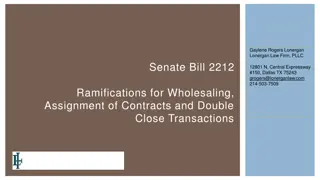Pitfalls of Real Estate Ownership in Corporations
Ownership of real estate by a C corporation can lead to double taxation issues, making it a less favorable choice. The taxation implications on the sale/liquidation of real estate held by a corporation, whether C or S, can result in high tax rates, reducing the net gains for shareholders. Understanding these tax effects is crucial when considering real estate ownership within a corporate structure.
Download Presentation

Please find below an Image/Link to download the presentation.
The content on the website is provided AS IS for your information and personal use only. It may not be sold, licensed, or shared on other websites without obtaining consent from the author. Download presentation by click this link. If you encounter any issues during the download, it is possible that the publisher has removed the file from their server.
E N D
Presentation Transcript
Real Estate in Corporations: Don t Do It! 1
Real Estate in Corporations Ownership of real estate by a C corporation is usually a bad idea. (Same for S corporations, but not as bad) Double taxation is a common problem when real estate is owned by a C corporation. When appreciated real estate is sold, the corporation will pay Federal tax at the corporate tax rates. Under the rules governing distributions from C corporations, the same income is taxed again at the shareholder level when it is distributed to the shareholders. There are no easy methods for removing appreciated real estate out of a C corporation. However, the problem usually gets worse if it is not addressed. 2
Real Estate in Corporations (Contd.) Problem: Double taxation on sale/liquidation. Example #3: X transfers Blackacre with a value of $1,000,000 and a basis of $400,000 to a corporation. The next day the corporation liquidates. 3
Real Estate in Corporations (Contd.) C Corporations A liquidating distribution is treated as a sale by the corporation. ( 311) The tax effects of liquidation would be $600,000 of gain to the corporation resulting in tax of 35% x $600,000 = $210,000. This would leave $790,000 of cash. The gain to the shareholder would be $790,000 - $400,000 = $390,000. Assuming long-term capital gains, at 23.8% or $92,820, leaving a net of $697,180. This means that a tax of $302,820 is paid on $600,000 of appreciation: a total tax rate of over 50%. 4
Real Estate in Corporations (Contd.) S Corporations Section 311 still applies. Section 1374 imposes a Big Tax on appreciated property contributed to an S corporation which is then sold (including distributions to shareholders) within 5 years thereafter. 5
Real Estate in Corporations (Contd.) In the above example, if the Big Tax applies, the corporation would still have to recognize $600,000 of gain and there would still be a 35% tax or $210,000. Additionally, the shareholder has pass-through capital gains of $600,000 As a result of the deemed sale, the basis of the shareholder s stock would be increased by $600,000 to $1,000,000. There would be $790,000 available to be distributed resulting in a loss to the shareholder of $210,000 which would be a capital loss. This would reduce the pass through of gain by $210,000, leaving a net of $390,000 of capital gain which would be subject to a tax of $92,280. The total tax would therefore again be $302,280. 6
Real Estate in Corporations (Contd.) Parity Between C Corporations and S Corporations Based on the foregoing example, there is relative parity between a C and an S corporation if 1374 applies. 7
Real Estate in Corporations (Contd.) If the Big Tax doesn t apply then the math is as follows: $600,000 of K-1capital gain producing a tax of $142,800. Zero tax on liquidation because the outside basis is increased by $600,000. 8
Real Estate in Corporations (Contd.) Mismatching Issue The parity is distorted, however, if there is a mismatching of capital gain and ordinary income. Example: Assume the same facts but that the property is improved and the value/basis allocation between the land and building is: Asset Value Basis Land $100,000 $200,000 Building $300,000 $800,000 Even assuming no depreciation recapture, IRC 1239 would apply causing the gain in the buildings to be recognized as ordinary income. The loss on the stock would be capital. Hence, the tax burden to the shareholders would be exacerbated. 9
Real Estate in Corporations (Contd.) Even assuming no depreciation recapture, IRC 1239 would apply causing the gain in the buildings to be recognized as ordinary income. The loss on the stock would be capital. Hence, the tax burden to the shareholders would be exacerbated. 10
Real Estate in Corporations (Contd.) Potential solutions to mitigating tax issues: Commit Suicide (Or in community property states kill your spouse) Section 1014 will step up the basis in the stock and, when this is coupled with the adjustment for the pass-through gain, will mitigate the tax bite, whether in an S or C Corp. 11
Real Estate in Corporations (Contd.) What if the shareholder dies without a Big Tax? Under 1014, the stock basis is increased to $1,000,000 on sale the $600,000 of gain in passed through to the shareholder. The stock basis is increased by $600,000 to $1,000,000 so there is an offsetting capital loss resulting in a net zero tax. 12
Real Estate in Corporations (Contd.) Additional potential solutions to mitigating tax issues (Cont d.): Convert to an S Corporation Wait 5 Years The Big Tax burns off after 5 years and will elevate the 1374 tax. 13
Real Estate in Corporations (Contd.) Additional potential solutions to mitigating tax issues (Cont d.): Freeze Techniques Have the S corporation form a limited liability company with the shareholders. Use the permissible estate tax IRC 2701 freeze technique to cap off further appreciation in the real estate. Beware of business purpose, economic subclause, etc. issues. See Cox case discussed below. 14
Real Estate in Corporations (Contd.) POPE vs. TALBOT Divide the property ownership to decrease the value and reduce taxes Example: S or C corporation forms a limited partnership. The General Partner is either a sister entity, a newly found entity, or a shareholder as to a 1% interest bona fide consideration is paid. The corporation is issued limited partnership shares and thus declares a dividend of 49% of the limited partner shares to the shareholders. What is the value of those shares? Is it a discounted value or not? 15
Real Estate in Corporations (Contd.) POPE vs. TALBOT In both Talbots and TAM 200443032, 100% of the limited partnership units were distributed. A case decided after Talbots, Cox Enterprises v. Commissioner, T.C. Memo 2009-134, may lead to a different result if less than all of the limited partnership units are distributed and the transaction has a business purpose and the transaction is old and cold. 16
Real Estate in Corporations (Contd.) Query: What would the affect of the 2704 regs. on a Pope v. Talbot transaction be? Can 2704 be avoided of TIC interests are used? 17
Real Estate in Corporations (Contd.) In Cox Enterprises, Inc. v. Commissioner, a recent Tax Court memorandum decision, the question of whether the corporation was required to recognize gain in such a transaction arose in the context of the taxpayer s motion for summary judgment. The taxpayer conceded, for purposes of the motion, that the fair market value of the property transferred by a corporation to the partnership substantially exceeded the fair market value of the partnership interest received by the corporation in exchange. The court concluded that, notwithstanding this concession, no distribution resulting in taxable gain to the corporation would be considered to have occurred, because there was no evidence that the discrepancy resulted from any intention by the controlling shareholders to cause the corporation to confer a benefit on the other partners. 18
Corporations Transfer of Value to Shareholders Using Partnership Pope & Talbot, Inc., 162 F3d 1236 (9th Cir. 1999) The Ninth Circuit, affirming the Tax Court, held that when a corporation transferred appreciated property to a limited partnership and then distributed the partnership interests to its shareholders, the corporation's recognized gain under Sec. 311 is measured by valuing the underlying assets (rather than the partnership interests) on the date of the distribution. The Ninth Circuit concluded that it would be more appropriate to rely on the testimony of valuation experts to determine the value of the properties transferred to the partnership on the distribution date. The dissenting opinion argued that the majority's interpretation of the "plain meaning" of the statute leads to an anomaly in which the value of property received by shareholders differs from the value of property distributed by the corporation. 19
Corporations Transfer of Value to Shareholders Using Partnership (Cont d.) Cox Enterprises, Inc. Subsidiaries v. Comr., T.C. Memo 2009-134 Court held that a corporation s contribution of a television station to a partnership did not constitute a dividend even though the partnership interest it received was originally worth $60.5 million less than the assets it contributed. The IRS argued that the transfer to the partnership should be deemed an indirect distribution to the remainder of the trusts and therefore a distribution to the trusts. 20
Corporations Transfer of Value to Shareholders Using Partnership (Cont d.) Judge Halpern rejected the IRS contention. First, he held that the corporation s transfer to the partnership was not intended to provide a gratuitous economic benefit to the other partners.... Second, he held that, even if the corporation had made such a gratuitous transfer, the transfer did not benefit the shareholder trusts. Several factors demonstrated that the corporation s directors did not intend a gratuitous transfer: The partnership s formation had nontax business reasons. As recommended by independent consultants, the corporation tried to sell these operating assets but was unable to do so. The partnership s formation allowed the corporation to retain, for use in other areas, the working capital it had previously needed for the television station. The corporation s board s executive committee adopted a resolution that the other partners be required to make cash contributions to the partnership in an amount corresponding to the fair market value of the partnership interests acquired by those other partners. 21
Corporations Transfer of Value to Shareholders Using Partnership (Cont d.) The other partners acquisition of partnership interest was to be on terms and conditions no less favorable to the corporation than the terms and conditions that would apply in a similar transaction with persons who are not affiliated with the corporation. The corporation retained an outside accounting firm to render an opinion of appropriate marketability and minority interest discounts applicable to a minority interest in the partnership as of the date of formation. The partners made contributions based on the appraised amount. Three years later, the corporation s management discovered errors in computing the other partners interests in the partnership and obtained a new appraisal. The other partners made additional contributions to bring their contributions up to the appraised value. The court relied on United States v. Byrum, 408 U.S. 135, 137-138 (1972), to find that the controlling shareholders were subject to fiduciary duties to the minority shareholders. In the Cox case, two percent of the stock was owned by people who were not members of the controlling family; these minority shareholders were principally employees of the corporation. Judge Halpern pointed out that the minority shareholders did not own interests in the other partners and would not be made financially whole for the likely shortfall in income and liquidation (or sale) proceeds if the corporation s contribution to the partnership constituted a transfer to the other partners. 22























